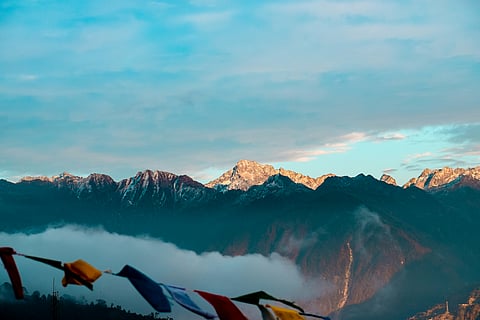
- Destinations
- Experiences
- Stay
- What's new
- Celebrating People
- Responsible Tourism
- CampaignsCampaigns
- SubscribeSubscribe
- Buy Now

Arunachal Pradesh boasts stunning landscapes characterised by roaring rivers, dense forests, stunning sanctuaries, and lush, rolling hills that beckon adventurers and nature lovers alike. As of 2025, this northeastern state has distinguished itself as the premier destination for adventure travel, as per the latest rankings by adventure tour operator Aquaterra Adventures India Pvt Ltd. The tour operators have been expertly curating treks and thrilling river rafting experiences across the Indian Himalayas since 1995, highlighting the state’s growing appeal.
Among the many treasures waiting to be discovered in Arunachal Pradesh is the remarkable Nimok Pung. Nestled in Subang village in Tirap district, this unusual saltwater well is not only a geographic curiosity but also holds deep historical and cultural significance among locals. Its unique properties and surroundings make it a potential focal point for tourism in the area.
With strategic investment from the government in its infrastructure and promotion, Nimok Pung could become a popular attraction, drawing visitors interested in adventure and cultural exploration.
Nimok Pung has been a vital lifeline for generations of the Nocte tribe community. This natural wonder features salty water—an uncommon trait in a landlocked, mountainous region. Yet, beyond its unusual characteristics, Nimok Pung holds deep cultural significance, intricately interwoven with the rich traditions of the barter economy that once thrived in the area.
For centuries, the salt extracted from this ancient well has been a cornerstone of village life, woven into the fabric of the community’s culture and economy. Villagers employed an intricate and time-honoured technique called "sumkoakin nocte," a phrase that melds sum ("salt") with koak ("to extract"). This traditional method required painstaking effort—sometimes consuming an entire week—as villagers worked hard to draw out this precious commodity.
The salt was not merely a seasoning to enhance flavours in meals; it served as a vital currency that facilitated trade during the barter system age. Armed with sacks of salt, locals ventured to neighbouring markets, where they exchanged this invaluable resource for essential staples. The trade rituals during these exchanges were not just economic transactions; they were pivotal social gatherings that strengthened community ties.
The well itself is viewed as a sacred site. Elders often recount how their forefathers held a deep belief that the salt from Nimok Pung had remarkable properties, including the ability to ward off illnesses and protect against disease. This historical significance turns the well into more than a mere source of salt; it symbolises their cultural identity and ancestral heritage, reminding them of their resilience and connection to the past.
In recent years, Nimok Pung has garnered significant attention for its potential to transform tourism in Arunachal Pradesh. Arunachal Pradesh's Forest Minister, Wanki Lowang, has actively expressed his enthusiasm for promoting this hidden treasure. However, local communities are urging the government to take more concrete and ambitious steps to realise Nimok Pung's full tourism potential.
With targeted investments in essential infrastructure—such as improved roads, welcoming accommodations, and visitor centers—and a robust marketing strategy that highlights the area's rich cultural heritage and stunning natural beauty, Nimok Pung could attract travellers from every corner of the country and beyond. This influx of visitors would not only invigorate the local economy but also create a wealth of job opportunities for residents in hospitality, guiding, and local artisan crafts.
Developing lesser-known places like this will align with the state's policy to explore new tourism potential in the area. For instance, in 2024, Arunachal Pradesh launched a tourism policy focusing on film tourism, farming experiences, wine-making, and eco-tourism. Known for its natural beauty and diverse tribal cultures, the state aims to attract both domestic and international visitors through unique and immersive experiences.
The charming hill station of Khonsa is the headquarters of the Tirap district and uniquely positioned, bordering Myanmar to the east and Assam to the south. Nestled in Tirap Valley, this town sees streams winding through deep gorges, dense woodlands, and snow-capped hills. The forests around Khonsa team with rare orchids and diverse wildlife. For adventure seekers and nature lovers, exhilarating treks through these vibrant forests offer unforgettable experiences.
Khonsa Museum in Tirap district was established in 1956. It is home to a captivating collection of artifacts that celebrate the region's rich and diverse culture. Experience the artistry of historic weapons, including beautifully crafted swords; immerse yourself in the vibrant handlooms and crafts representing various cultures; and admire the intricate cane and bamboo works that reflect the creativity and skill of local artisans.
Recently, a group of trekkers discovered a stone cave near the Arunachal-Myanmar border. This cave is believed to have served as a transit camp for Allied Forces during World War II. The discovery was made by a group of 27 trekkers led by Tagit Sorang, an experienced Everest climber. While climbing through the hills of Tirap district, located in the southeastern part of Arunachal Pradesh, the trekkers found a stone cave at Longpongka Point, at an altitude of 2,119 m. According to reports, this cave was strategically positioned to slow down the advances of the Japanese army during the war. Read more about it here.
To reach Tirap in Arunachal Pradesh, the best option is to fly to Dibrugarh Airport, which is the nearest airport, located about 120 kms away. From there, you can travel to Tirap by road using a bus or taxi. Please note that there is no direct train service to Tirap, and the closest railway station is Naharkatiya, approximately 70 kms away.
